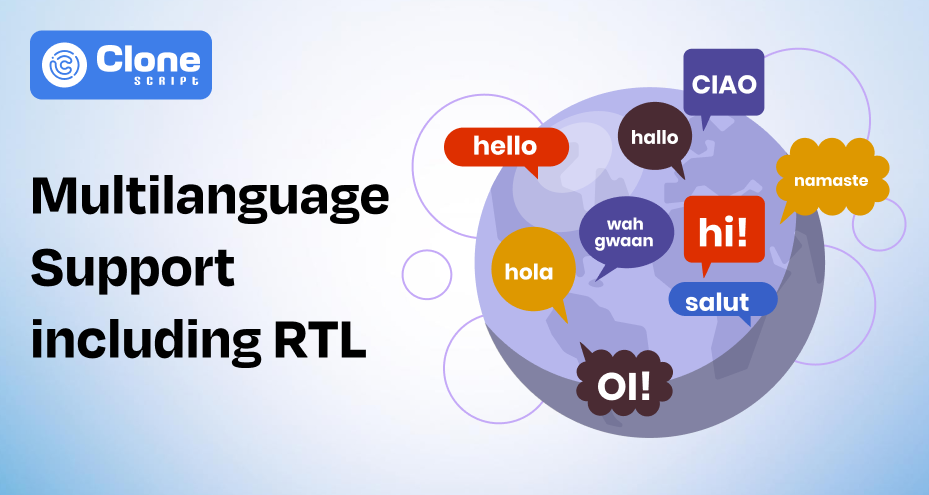5 Top Benefits of Having a Multilingual Website for Your Business
Having a business website doesn’t guarantee that people from every corner of the world see it until it supports multilingual options, where users can explore the site in their local language.
In fact, research shows that 76% of consumers prefer to buy from websites in their native language. Ignoring this fact can create a worse situation for the brand, resulting in less recognition, revenue, and market share.
In this article, we will understand why businesses need multilingual websites, their role in search rankings improvement, etc.
Benefit No. 1: It Helps Expand Your Global Reach.
Most of the startup websites find that they will not have enough sales through organic search results. The reason is that they have only a single language that targets users to only certain regional customers. But they never look at other potential markets where their products or services are always in demand. Having a multilingual website breaks down that barrier and opens the door to global opportunities.
-
Here’s the reality: 40% of consumers won’t buy from a website that’s not in their native language. That means if your business operates only in English, you could be missing out on nearly half of your potential audience.
-
On the other hand, by investing in website translation and localization, you immediately make your products or services accessible to people who might have otherwise passed you by.
For example, an e-commerce brand in the U.S. that translates its website into Spanish doesn’t just cater to Latin American markets—it also gains stronger visibility among Spanish-speaking communities in the U.S. itself. This dual impact is one of the strongest benefits of a multilingual website: it doesn’t just grow your international footprint, it strengthens your reach at home too.
Expanding your global reach isn’t about offering every language under the sun—it’s about being strategic. By focusing on a few high-impact markets and languages, you can:
-
Enter new markets with relatively low investment.
-
Offer language support that makes international visitors feel valued.
-
Increase engagement and conversion rates by reducing language friction.
In short, if you’re wondering how to attract global customers with a multilingual website, the answer is simple: speak their language, and you’ll earn their attention.
Benefit No.2: Multilanguage Support in Website Boosts Search Rankings
One of the less obvious but most powerful benefits of a multilingual website is the impact it can have on your search engine visibility. When you create content in different languages, you’re not just making your site readable—you’re also giving search engines more reasons to rank you higher in multiple regions.
Think about it: Google doesn’t treat a Spanish query the same as an English one. If your site only exists in English, you’re competing with millions of global businesses for the same set of keywords. But once you add website translation and properly optimize it with SEO best practices, you suddenly have the chance to rank for searches in Spanish, French, German, Mandarin, or whichever markets you’re targeting.
Here’s what that means for your business:
-
Higher visibility in local markets: A global website that has localized pages is more likely to appear in local search results.
-
Better click-through rates: People are more likely to click on titles and meta descriptions written in their own language.
-
Less competition: Instead of battling for broad English keywords like “best accounting software,” you could rank faster for a localized search like “meilleure comptabilité en ligne” in French.
The numbers back this up. Research shows that businesses that invest in website localization bring a 40-50% lift in organic traffic compared to a single-language website. It will be considered a qualified lead that can convert into a sign-up, purchase, or contact. These leads are from users who are actively searching in their language for what you sell.
The bottom line: every additional language is like adding a new lane for traffic to flow into your business. In a digital world where visibility equals revenue, that’s an edge you can’t afford to ignore.
Benefit No.3: Language Support in Website Builds Trust & Stronger Relationships.
Trust is the key to any business relationship, and language plays a much bigger role in building that trust than most companies realize. A multilingual website tells your audience: “We see you, we value you, and we want to meet you on your terms.”
It’s not just about convenience—it’s about credibility.
-
Studies show that 75% of consumers are more likely to make repeat purchases from brands that offer support in their native language. When customers can browse, buy, and ask questions in a language they’re comfortable with, they feel more confident in their decision. That confidence translates into loyalty.
Consider two online stores selling the same product. One only offers English, while the other provides language support in English, Spanish, and French. Even if the price and product are identical, most international customers will choose the site that “speaks” their language.
Why?
Because it feels more trustworthy, more human, and more aligned with their needs.
Adding website translation and localization also helps you avoid costly miscommunications. Direct translations can sometimes create awkward or even misleading messaging. But when you localize your website—adapting phrases, tone, and even visuals—you’re showing cultural sensitivity, which deepens trust further.
In practice, this trust-building extends beyond the initial sale. Offering multilingual support services in areas like customer service chat, FAQs, or email updates ensures that your relationship with customers continues long after checkout.
If you’re aiming to improve customer trust with multilingual support, remember: language isn’t just a communication tool—it’s a bridge. The stronger you build it, the longer customers will stay with you.
Benefit No.4: It Offers a Competitive Edge for Small Businesses.
Small businesses often assume that going multilingual is only for big corporations with deep pockets. But in reality, a multilingual website for small businesses can be one of the smartest, most cost-effective ways to compete with larger players.
Here’s why:
-
Professional image on a budget: A local company with a well-designed global website in just two or three languages can instantly look more established and trustworthy, even compared to bigger competitors.
-
Access to underserved markets: Many regions have limited online content in their local language. By offering website translation into those languages, small businesses can win customers that larger brands are overlooking.
-
Faster brand recognition: When your site “speaks” directly to international audiences, you’re not just selling a product—you’re positioning your brand as globally relevant.
Take, for example, a boutique skincare brand in Canada. By adding website localization in French and Spanish, it doesn’t just expand into European and Latin American markets—it also becomes more appealing to Canada’s French-speaking population and U.S. Spanish-speaking communities. That’s a massive customer base unlocked with a relatively small investment.
The truth is, globalization isn’t just for the big players anymore. Digital tools and cost-effective multilingual website solutions have leveled the playing field. Even a solo entrepreneur can now serve customers across borders with the right language support.
For small businesses, this isn’t about chasing every market at once. It’s about being strategic—choosing two or three languages that matter most, testing the waters, and building gradually. Done well, it gives you a competitive edge that larger companies can’t always match in terms of agility and personalization.
Benefit No.5: Multilingual Support on the Website is a Cost-Effective Growth Strategy.
Expanding into new markets brings to mind expensive international offices, large-scale ad campaigns, and complex logistics. But one of the most cost-effective growth strategies for modern businesses is simply investing in a website with a local language translation.
Why? Because it allows you to scale globally without the heavy overhead. Here’s how:
-
Lower upfront costs: Compared to physical expansion, website translation and localization require a affordable amount of the budget. Even targeting two or three high-value languages can deliver strong returns.
-
Scalability: Once the framework for language support is in place, adding new languages is straightforward. You can grow at your own pace, testing markets before committing further investment.
-
Targeted marketing: A multilingual site lets you run localized campaigns that resonate better with specific audiences, reducing wasted spend on generic ads, including search and paid social media ads.
Many businesses are turning to cost-effective multilingual website solutions that balance automation and accuracy.
-
AI-powered translation tools can quickly scale content across multiple languages.
-
Professional translators refine key sections like product descriptions, landing pages, and customer support material.
This hybrid approach offers both efficiency and cultural relevance.
The numbers speak for themselves. Studies have shown that companies with localized websites are 1.5 times more likely to increase revenue from international markets. For small and mid-sized businesses, this makes multiple language support one of the fastest paths to sustainable global growth.
In short, a website with a local language doesn’t just save costs compared to traditional expansion—it turns your website into a growth engine, generating leads and sales across borders without needing to invest in brick-and-mortar operations.
How to Integrate Multilingual Support Into Your Website?
It’s not just enough to know the benefits of a website supporting more than one local language. The effective implementation also matters, and for it, a strategic plan works. Follow the things:
1. Identify Your Target Markets
Start by asking: Where are my potential customers? Look at your website analytics to see which countries are already visiting your site. Prioritize languages that match both traffic data and your long-term business goals.
2. Choose the Right Translation Approach
Common options for language translation on a website include:
-
Professional translation services: Best for accuracy, nuance, and cultural adaptation.
-
Automated tools: Quick and scalable, ideal for testing new markets.
-
Hybrid solutions: A mix of AI-powered translation with human editing keeps a balance between cost and quality.
3. Focus on Website Localization, Not Just Translation
Translation alone may miss cultural context. Website localization ensures that images, currencies, date formats, and even tone of voice align with local preferences. For example, a color that represents luck in one culture might symbolize danger in another—localization helps you avoid those pitfalls.
4. Optimize for Multilingual Search Engine Optimization
Each language version of your site needs a proper setup. That means:
-
Adding hreflang tags so search engines serve the right language to the right audience.
-
Doing localized keyword research instead of directly translating English terms.
-
Writing meta titles and descriptions in the local language for better click-through rates.
5. Extend Language Support Beyond the Website
A true multilingual website support service doesn’t end with page content. Offer multilingual chat support, localized FAQs, and translated post-purchase emails. This consistency reassures customers that you’re serious about serving their needs.
By taking these steps, businesses can move from simply “having” a multilingual site to building a seamless global experience that attracts, converts, and retains customers worldwide.
Need a reliable solution for your site’s language support? Here’s our recommendation.
Why Choose AllClone Scripts for Professional Multilingual Website Support?
Getting professional support for multilingual integration into a website is important. It can free your site from poor translations, broken layouts, or the mistakes of RTL (Right-to-Left) language support. Here, the AllClone Script can be helpful.
We specialize in building seamless websites supporting local languages that don’t just display content in different languages but truly enhance the customer experience. Our service goes beyond simple translation by focusing on:

-
Flawless Multilanguage Integration: Add as many languages as you need without disrupting your website’s performance.
-
RTL Language Compatibility: Perfect for businesses expanding into Arabic, Hebrew, or Urdu-speaking markets.
-
User-Friendly Language Switching: Allow visitors to move between languages effortlessly, improving accessibility.
-
Cultural Customization & Localization: Adapt not only words but also design elements for better trust and engagement.
-
End-to-End Support & Maintenance: From setup to bug fixes, they provide continuous assistance so your website always works smoothly.
For businesses serious about global growth, this isn’t just a service—it’s a strategic investment. By partnering with AllClone Scripts, you get more than a multilingual website; you get a global-ready business platform that builds trust, attracts customers, and drives sales.
Ready to go global? Explore AllClone Scripts’ multilingual website solutions. Contact us for any queries you have.
Conclusion
With a multilingual website, your business is not limited to only a single region, but it is easily accessible to global customers who prefer localized content. It doesn’t matter if you’re an e-commerce startup, a mid-sized digital marketing team, or a large-scale IT organization; the multiple language support makes it easier to sell the products and services. When you do it right, you’re gaining visibility along with trust, loyalty, and proper growth itself.
FAQs
-
How many languages should a business website support?
It depends on your goals and audience. Start with 2–3 high-impact languages where you already see traffic or demand, then expand gradually as your business grows.
-
Does a multilingual website slow down performance?
Not if it’s built properly. With optimized plugins, caching, and professional support, your site can handle multiple languages without affecting speed.
-
Can I add multilingual support to my existing website, or do I need a redesign?
In most cases, you can integrate multilingual features into your existing site. However, older sites may benefit from an upgrade for smoother language integration.
-
How does a multilingual website help travel and tourism businesses?
Travelers want to book hotels, tours, or tickets in a language they’re comfortable with. A multilingual site builds trust, improves the booking experience, and positions your brand as traveler-friendly.
-
What’s the difference between machine translation and human translation?
Machine translation (like Google Translate) is fast and affordable, but can miss cultural nuances. Human translation is more accurate and trustworthy, especially for customer-facing content.
-
How do I measure the success of my multilingual website?
Track metrics like international traffic growth, localized keyword rankings, conversion rates by region, and customer engagement across languages to see the impact of integrating multilingual support.
-
Is multilingual support only about text?
No. True website localization includes adapting visuals, payment options, date formats, and even colors to fit cultural expectations.
-
What’s the benefit of multilingual support for e-learning platforms?
E-learning platforms are successful when learners can study in their preferred language. Translating courses, assessments, and support materials makes education more inclusive and expands the platform’s global reach. It also boosts learner engagement and completion rates.
-
How can a multilingual website help an e-commerce store?
For e-commerce, offering local language support directly impacts sales. Customers are far more likely to add items to their cart when product descriptions, checkout pages, and customer service are in their native language. It also reduces cart abandonment caused by confusion or mistrust.
-
Is multilingual support useful for SaaS or tech companies?
Absolutely. Tech users often search for software in their native language. Offering website localization for your SaaS product pages, documentation, and support helps you stand out in competitive global markets.
-
Why should digital marketing agencies consider multilingual websites?
A multilingual presence allows agencies to attract international clients and run localized campaigns. By showing they understand cultural nuances, agencies can prove their value in reaching diverse audiences through tailored digital strategies.
 BTC - Bitcoin
BTC - Bitcoin
 USDTERC20 - USDT ERC20
USDTERC20 - USDT ERC20
 ETH - Ethereum
ETH - Ethereum
 BNB - Binance
BNB - Binance
 BCH - Bitcoin Cash
BCH - Bitcoin Cash
 DOGE - Dogecoin
DOGE - Dogecoin
 TRX - TRON
TRX - TRON
 USDTTRC20 - USD TRC20
USDTTRC20 - USD TRC20
 LTC - LiteCoin
LTC - LiteCoin







